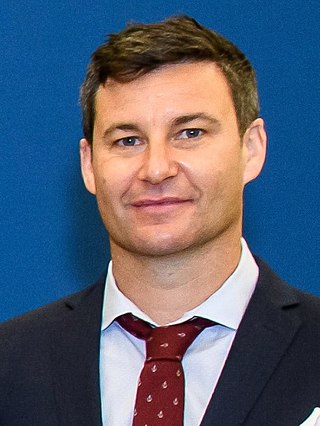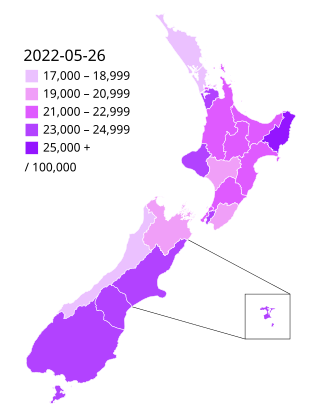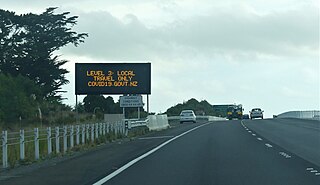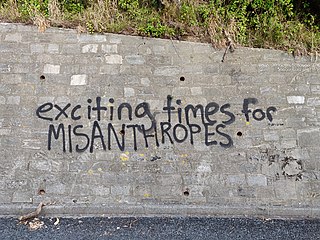2020
On 21 March 2020, Prime Minister Jacinda Ardern announced the introduction of a country-wide alert level system, similar to the existing fire warning systems. There are four levels, with 1 being the least risk of infection and 4 the highest. At the time of the announcement, New Zealand was at level 2. Each level brings added restrictions on activities or movements. Each region can have an individual alert level based on the severity of their own infections, and these levels can be changed at any time. [8] [9]
At the time of Ardern's announcement, New Zealand was at alert level 2. [10] Ardern announced on 23 March that, effective immediately, New Zealand would be at alert level 3, moving to level 4 at 11:59 pm on 25 March. [11] On 20 April, Ardern announced that New Zealand would move to alert level 3 at 11:59 pm on 27 April, with businesses and schools being allowed to have employees enter the premises during the last week of alert level 4 to prepare the facility for the transition to alert level 3. [12]
The country remained at alert level 3 for at least two weeks, with the decision of whether to move down to level 2 made on 11 May. [13] On 11 May, it was announced that New Zealand would enter alert level 2 from 11:59 pm on 13 May, lifting lockdown restrictions while maintaining physical distancing in public and for private gatherings with more than ten people. [14] On 8 June, Ardern announced that the country would enter alert level 1 at 11:59 pm that night, lifting the remaining restrictions. [15]
After new cases of community transmission were detected on 11 August, New Zealand was moved to alert level 2 and Auckland to level 3 at noon on 12 August; [16] Auckland moved down to level "2.5", a modified version of level 2 with further limitations on public gatherings and mandated mask wearing on public transport, at 11:59 pm on 30 August. [17] New Zealand moved to level 1 on 21 September at 11:59 pm while Auckland moved to level 2 on 23 September at 11:59 pm. [18] Auckland moved down to level 1 on 7 October at 11:59 pm. [19]
2021
On 14 February 2021, after the new community cases were detected in Auckland, Auckland moved to alert level 3 at 11:59 pm, while the rest of New Zealand moved to alert level 2. [20] Auckland moved down a level to alert level 2, while the rest of New Zealand moved to alert level one, at 11:59 pm on 17 February. [21] Auckland moved down to level 1 on 22 February at 11:59 pm. [22] Auckland moved up to level 3, while the rest of New Zealand moved to level 2 on 28 February at 6:00 am. [23] Auckland moved down to level 2, while the rest of New Zealand moved to level 1 at 6:00 am on 7 March. [24] On 12 March, Auckland moved back to level 1 at midday. [25]
On 23 June 2021, the Wellington region including the Wairarapa and the Kāpiti Coast moved to Alert Level 2 at 6pm after a Sydney man travelled to the region while infected the SARS-CoV-2 Delta variant. The Wellington lockdown was scheduled to last until 11:59 pm on 27 June. [26] [27] On 27 June, Cabinet extended Wellington's Alert Level 2 lockdown for 48 hours until 11:59 pm on 29 June. [28] [29] [30] On 29 June, Wellington moved down to level 1 at 11:59 pm. [31]
On 17 August 2021, after a report of a new community case presumed to be infected with the Delta variant of the virus, Ardern announced that New Zealand would move to alert level 4 at 11:59 pm. New Zealand is expected to be at level 4 for a minimum of three days, while Auckland and the Coromandel Peninsula for 7 days. [32] [33] On 23 August 2021, Ardern announced that most of New Zealand will remain at alert level 4 until 11:59 pm on 27 August, while Auckland will remain at alert level 4 until 11:59 pm on 31 August. [34] [35] On 27 August, Ardern announced that New Zealand will remain on Alert Level 4 until 11:59 pm on 31 August. While Auckland and the Northland Region will remain on Alert Level 4 for at least two more weeks, the rest of the country will move into Alert Level 3 from 1 September 2021. [36] [37]
On 30 August, the Government hinted that Northland's alert level could be lowered to Alert Level 3 at 11:59 pm on 2 September 2021 if wastewater testing confirmed no traces of COVID-19. [38] On 2 September, Ardern confirmed that Northland would move to Alert Level 3 at 11:59 pm on 2 September since wastewater testing within the region had not detected COVID-19. Checkpoints will be set up between Northland and the Auckland Region, which remained under Level 4. [39]
On 6 September, Ardern confirmed that all of New Zealand except Auckland will move to Alert Level 2 at 11:59pm on 7 September. However, new Level 2 restrictions will be introduced including mandatory mask wearing at most public venues, recommended mask wearing for school students above the age of 12 years, a 50-person limit at indoor venues, and a 100-person limit at outdoor venues. [40]
On 13 September, Ardern confirmed that Auckland would remain on Alert Level 4 until 11:59 pm at 21 September; with five week period marking the longest that the region has been under Level 4. In addition, the rest of New Zealand would remain on Alert Level 2 until at least 21 September. [41] [42]
On 20 September, Ardern confirmed that Auckland would move down to Alert Level 3 at 11:59 pm on 21 September while the rest of the country will remain on Alert Level 2. Event limit restrictions were also relaxed for areas under Level 2, with 100 people being allowed in indoor hospitality venues. In addition, a "bespoke" lockdown requirement was established in Whakatīwai, Waikato due to recent community cases there. [43] [44] Whakatīwai was given a Section 70-stay-at-home order for the next five days while the Health Ministry conducted contact tracing. [45]
On 22 September, Director-General Ashley Bloomfield confirmed that Waikato's Whakatīwai region would be moving into Alert Level 3 with the rest of Auckland due to the high level of testing and negative community cases in the region. [46] [47]
On 3 October, an Alert Level three lockdown was reinstated in several parts of Waikato including Raglan, Huntly, Ngāruawāhia and Hamilton from midnight 4 October after two community cases were detected. [48] In response to the Waikato lockdown, Ardern stated that lockdowns would continue unless vaccination rates increased nationally. [49]
On 4 October, Ardern announced a three-stage strategy to move Auckland out of lockdown. The stages were:
- The first stage allowed people to connect with relatives outdoors, up to a maximum of 10 people and two households at a time; the resumption of early childhood education for everyone, and people to move around Auckland for recreation such as beach visits and hunting.
- The second stage allowed retailers to reopen with face masks and physical distancing requirements; allowed public facilities such as libraries and museums to reopen; and raise the maximum number of people able to meet outdoors to 25, removing the two-household limit.
- The (unused) third stage allowed hospitality businesses to reopen with special restrictions including compulsory seating, separation, and a 50-person limit; the reopening of close contact businesses like hairdressers with mask use and physical distancing; and raised the limit on gatherings to 50 people. [50] [51] [52]
On 5 October, Auckland moved into stage one of the Government's three-stage strategy at 11:59 pm on 5 October. [50]
On 7 October, COVID-19 Response Minister Hipkins extended the Waikato Level 3 boundary extension to include more parts of the region including the Waitomo (including Te Kuiti), Waipa, and the Ōtorohanga districts." The boundary also covers the coast south to Mokau, then east along the northern Pureora Forest Park, and north to include Te Awamutu, Karapiro and Cambridge to meet the existing boundary. [53] The following day, Alert Level 3 restrictions reinstated in the Northland Region after an Auckland woman who tested positive for COVID-19 used false information to obtain travel documents and spent several days in the region. [54]
On 11 October, Auckland's Level 3 lockdown was extended for another week, with students being asked not to return to class next Monday. The Government has indicated that Alert level restrictions in Waikato and Northland will be lowered from Alert Level 3 to Alert Level 2 on 14 October at 11:59 pm. [55]
On 18 October, Ardern confirmed that Auckland would remain on Alert Level 3 for at least two more weeks. Waikato would remain on Alert Level 3 due to further cases and positive wastewater testing results. Northland will remain on Alert Level 3 due to continuing community transmissions. [56]
On 1 November, Ardern announced that the Waikato region will move down to step 2 of Alert Level 3 at 11:59 pm on 2 November. This allows retailers to operate with face masks and physical distance; increases the number of people at outdoor gatherings to 25; and removes the two-household restriction. Auckland will move down to step 2 of Alert Level 3 at 11:59pm on 9 November. [57]
On 2 November, COVID-19 Response Minister Hipkins placed the northern part of the Northland Region under an Alert Level 3 lockdown after authorities were unable to find any epidemiological links for two community cases. [58]
On 8 November, Ardern announced that Auckland will move down to step 2 of Alert Level 3 from 10 November. Retail stores, museums and zoos will be allowed to reopen. Outdoor gatherings, funerals, weddings, and civil unions will be allowed with an increased 25 person limit. The Far North District, which was put into level 3 in the middle of last week, will also move down to alert level 2 on 12 November. Ardern also indicated that Cabinet expects to move Auckland into the COVID Protection Framework from 29 November 2021. [59] [60]
On 22 November, Ardern confirmed that New Zealand would enter the COVID-19 Protection Framework "traffic light system" from 3 December, ending the previous "alert level system." Auckland and areas with low vaccination would start on the "Red setting" (compulsory record-keeping, scanning, face masks, and limits on public gatherings) while the rest of the country would start on the "Orange setting" (Public facilities, education providers, workplaces and specified community events allowed to reopen subject to capacity limits while regional boundary restrictions are eased). In addition, hairdressers and barbers in Auckland were allowed to reopen from 25 November. [61] [62]






